2011 TOYOTA VERSO S Full cap
[x] Cancel search: Full capPage 3 of 664

3TABLE OF CONTENTS
1
6
5
4
3
2
8
7
9
Smart entry & start system . 223
4-3. Adjusting the seats
Front seats .......................... 270
Rear seats .......................... 271
Driving position memory ..... 273
Head restraints ................... 276
4-4. Adjusting the steering wheel
and mirrors
Steering wheel .................... 278
Inside rear view mirror ........ 279
Digital Rear-view Mirror ...... 280
Outside rear view mirrors.... 289
4-5. Opening, closing the win-
dows and moon roof
Power windows ................... 291
Panoramic moon roof ......... 294
5-1. Before driving
Driving the vehicle .............. 300
Cargo and luggage ............. 306
Trailer towing ...................... 308
5-2. Driving procedures
Power (ignition) switch ........ 317
Hybrid transmission ............ 321
Turn signal lever ................. 325
Parking brake...................... 326
Brake Hold .......................... 329
5-3. Operating the lights and wip-
ers
Headlight switch.................. 332
AHB (Automatic High Beam)
.......................................... 334
Fog light switch ................... 337
Windshield wipers and washer
.......................................... 338
Rear window wiper and washer
.......................................... 340
5-4. Refueling
Opening the fuel tank cap ... 342
5-5. Using the driving support sys-
tems
Toyota Safety Sense .......... 344
PCS (Pre-Collision System) 355
LTA (Lane Tracing Assist) .. 362
RSA (Road Sign Assist)...... 372
Dynamic radar cruise control
with full-speed range ........ 376
Cruise control...................... 388
Speed limiter ....................... 391
BSM (Blind Spot Monitor) ... 393
Toyota parking assist-sensor
.......................................... 414
PKSB (Parking Support Brake)
.......................................... 420
Parking Support Brake function
(static objects) .................. 424
Parking Support Brake function
(rear-crossing vehicles) .... 430
Driving mode select switch . 434
Trail Mode ........................... 435
GPF (Gasoline Particulate Filter)
system .............................. 437
Driving assist systems ........438
5-6. Driving tips
Winter driving tips ............... 445
Utility vehicle precautions ... 448
5Driving
Page 87 of 664
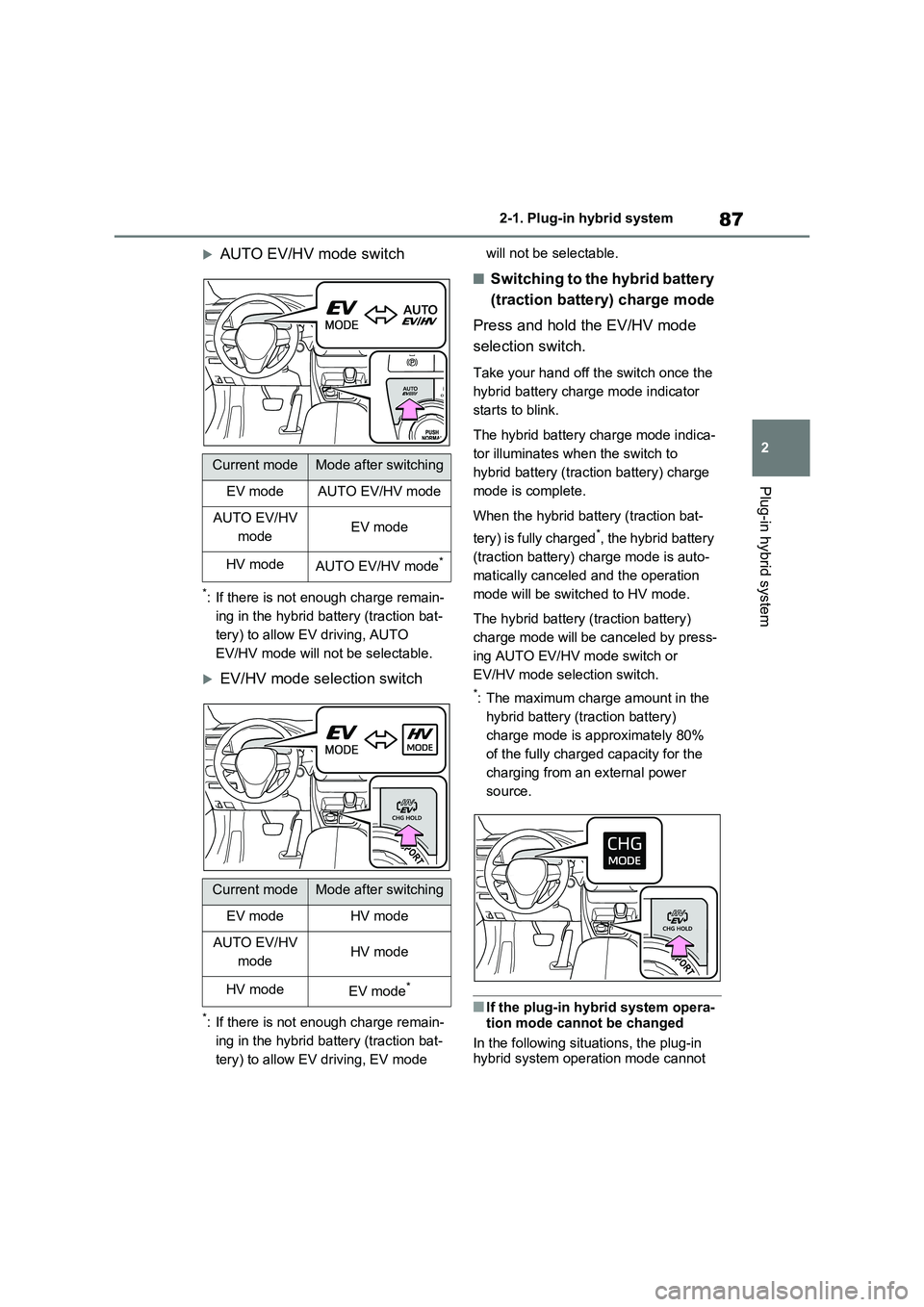
87
2 2-1. Plug-in hybrid system
Plug-in hybrid system
AUTO EV/HV mode switch
*: If there is not enough charge remain-
ing in the hybrid battery (traction bat-
tery) to allow EV driving, AUTO
EV/HV mode will not be selectable.
EV/HV mode selection switch
*: If there is not enough charge remain-
ing in the hybrid battery (traction bat-
tery) to allow EV driving, EV mode will not be selectable.
■Switching to the hybrid battery
(traction battery) charge mode
Press and hold the EV/HV mode
selection switch.
Take your hand off the switch once the
hybrid battery charge mode indicator
starts to blink.
The hybrid battery charge mode indica-
tor illuminates when the switch to
hybrid battery (traction battery) charge
mode is complete.
When the hybrid battery (traction bat-
tery) is fully charged
*, the hybrid battery
(traction battery) charge mode is auto-
matically canceled and the operation
mode will be switched to HV mode.
The hybrid battery (traction battery)
charge mode will be canceled by press-
ing AUTO EV/HV mode switch or
EV/HV mode selection switch.
*: The maximum charge amount in the
hybrid battery (traction battery)
charge mode is approximately 80%
of the fully charged capacity for the
charging from an external power
source.
■If the plug-in hybrid system opera-
tion mode cannot be changed
In the following situations, the plug-in
hybrid system operation mode cannot
Current modeMode after switching
EV modeAUTO EV/HV mode
AUTO EV/HV
modeEV mode
HV modeAUTO EV/HV mode*
Current modeMode after switching
EV modeHV mode
AUTO EV/HV
modeHV mode
HV modeEV mode*
Page 108 of 664
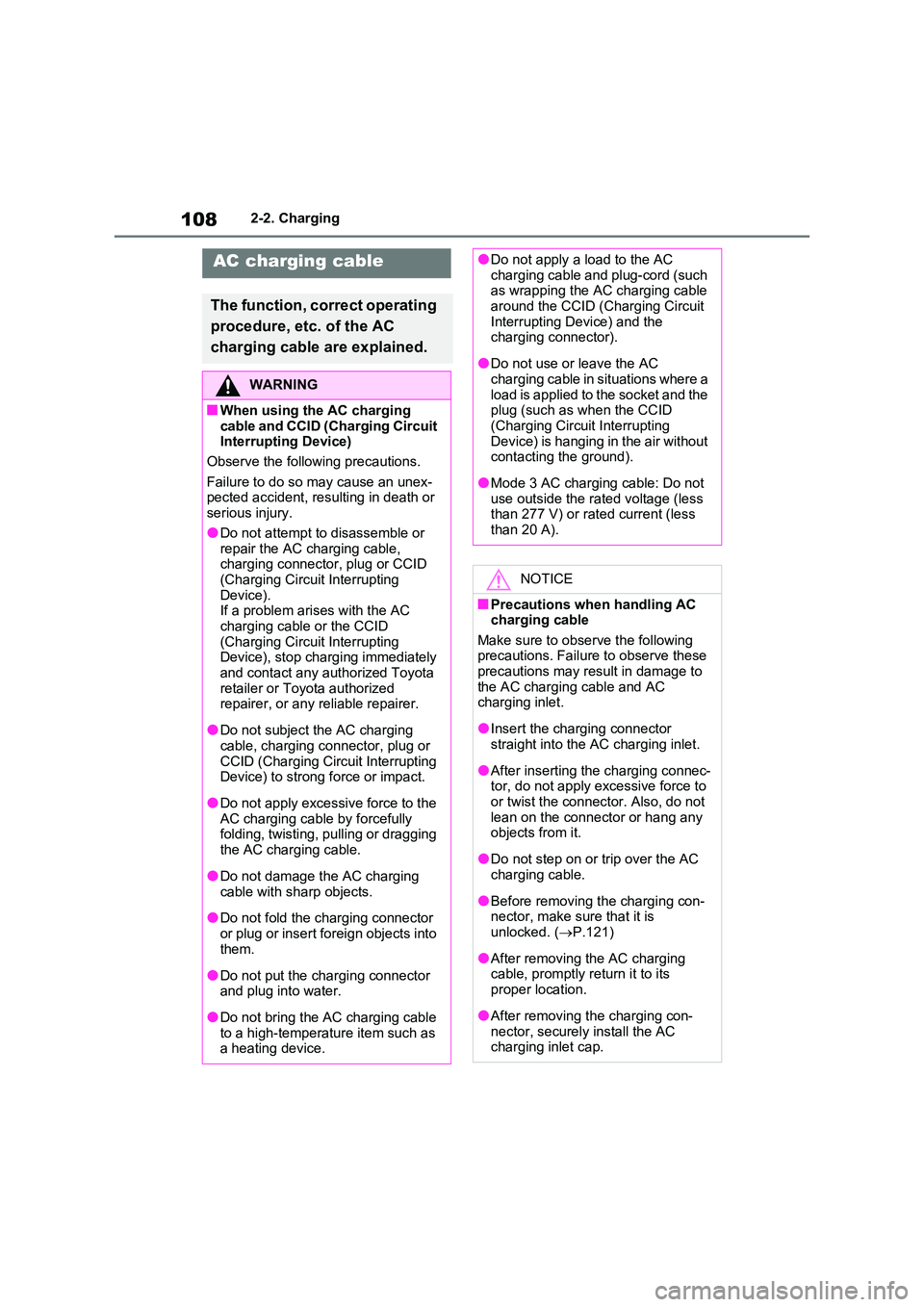
1082-2. Charging
AC charging cable
The function, correct operating
procedure, etc. of the AC
charging cable are explained.
WARNING
■When using the AC charging
cable and CCID (Charging Circuit Interrupting Device)
Observe the following precautions.
Failure to do so may cause an unex- pected accident, resulting in death or serious injury.
●Do not attempt to disassemble or repair the AC charging cable, charging connector, plug or CCID
(Charging Circuit Interrupting Device).If a problem arises with the AC
charging cable or the CCID (Charging Circuit Interrupting Device), stop charging immediately
and contact any authorized Toyota retailer or Toyota authorized repairer, or any reliable repairer.
●Do not subject the AC charging cable, charging connector, plug or
CCID (Charging Circuit Interrupting Device) to strong force or impact.
●Do not apply excessive force to the AC charging cable by forcefully folding, twisting, pulling or dragging
the AC charging cable.
●Do not damage the AC charging
cable with sharp objects.
●Do not fold the charging connector
or plug or insert foreign objects into them.
●Do not put the charging connector and plug into water.
●Do not bring the AC charging cable to a high-temperature item such as a heating device.
●Do not apply a load to the AC charging cable and plug-cord (such as wrapping the AC charging cable
around the CCID (Charging Circuit Interrupting Device) and the charging connector).
●Do not use or leave the AC charging cable in situations where a
load is applied to the socket and the plug (such as when the CCID (Charging Circuit Interrupting
Device) is hanging in the air without contacting the ground).
●Mode 3 AC charging cable: Do not use outside the rated voltage (less than 277 V) or rated current (less
than 20 A).
NOTICE
■Precautions when handling AC charging cable
Make sure to observe the following precautions. Failure to observe these precautions may result in damage to
the AC charging cable and AC charging inlet.
●Insert the charging connector straight into the AC charging inlet.
●After inserting the charging connec-tor, do not apply excessive force to or twist the connector. Also, do not
lean on the connector or hang any objects from it.
●Do not step on or trip over the AC charging cable.
●Before removing the charging con-nector, make sure that it is unlocked. ( P.121)
●After removing the AC charging cable, promptly return it to its
proper location.
●After removing the charging con-
nector, securely install the AC charging inlet cap.
Page 115 of 664
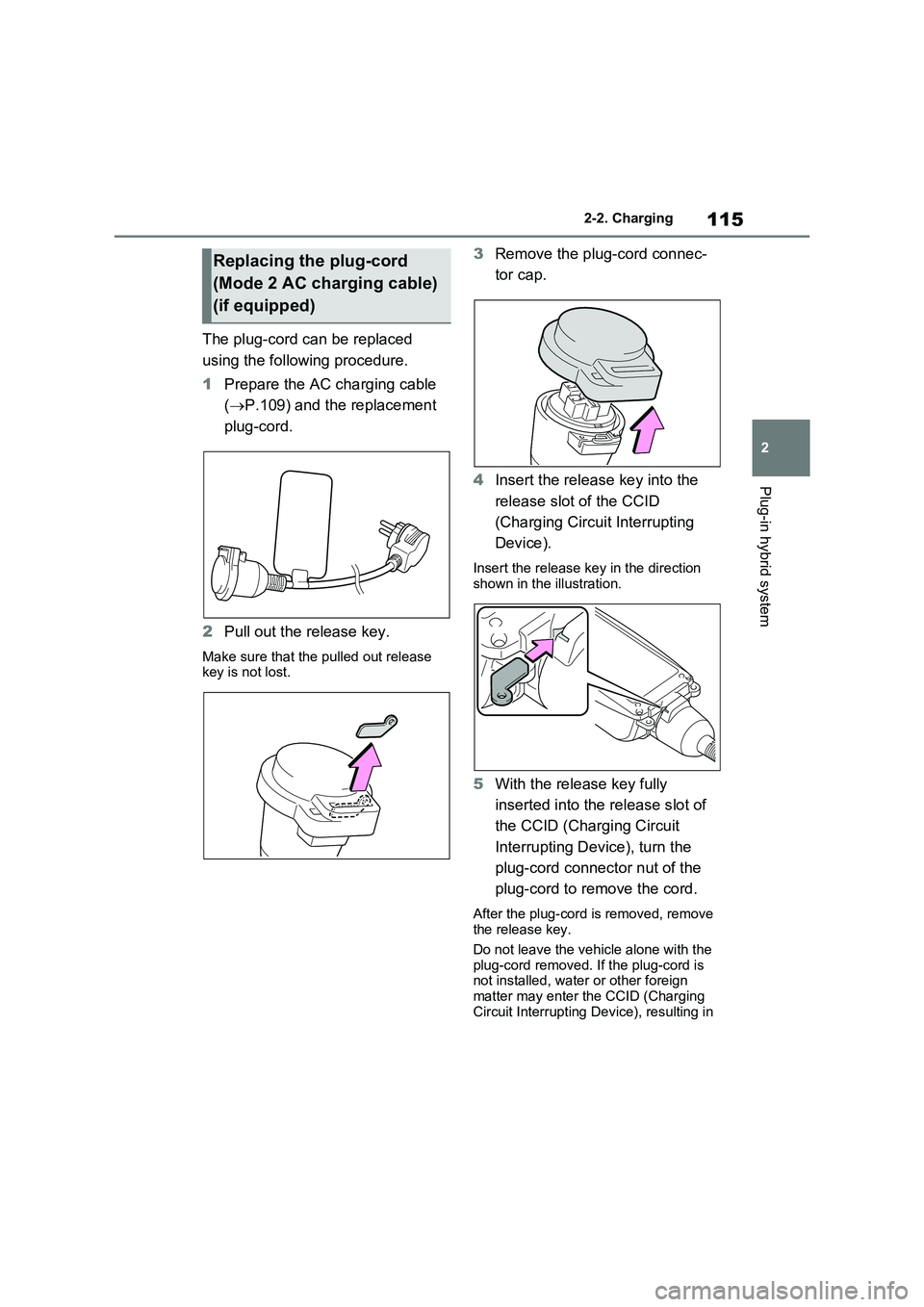
115
2
2-2. Charging
Plug-in hybrid system
The plug-cord can be replaced
using the following procedure.
1 Prepare the AC charging cable
( P.109) and the replacement
plug-cord.
2 Pull out the release key.
Make sure that the pulled out release key is not lost.
3 Remove the plug-cord connec-
tor cap.
4 Insert the release key into the
release slot of the CCID
(Charging Circuit Interrupting
Device).
Insert the release key in the direction shown in the illustration.
5 With the release key fully
inserted into the release slot of
the CCID (Charging Circuit
Interrupting Device), turn the
plug-cord connector nut of the
plug-cord to remove the cord.
After the plug-cord is removed, remove the release key.
Do not leave the vehicle alone with the
plug-cord removed. If the plug-cord is not installed, water or other foreign matter may enter the CCID (Charging
Circuit Interrupting Device), resulting in
Replacing the plug-cord
(Mode 2 AC charging cable)
(if equipped)
Page 127 of 664
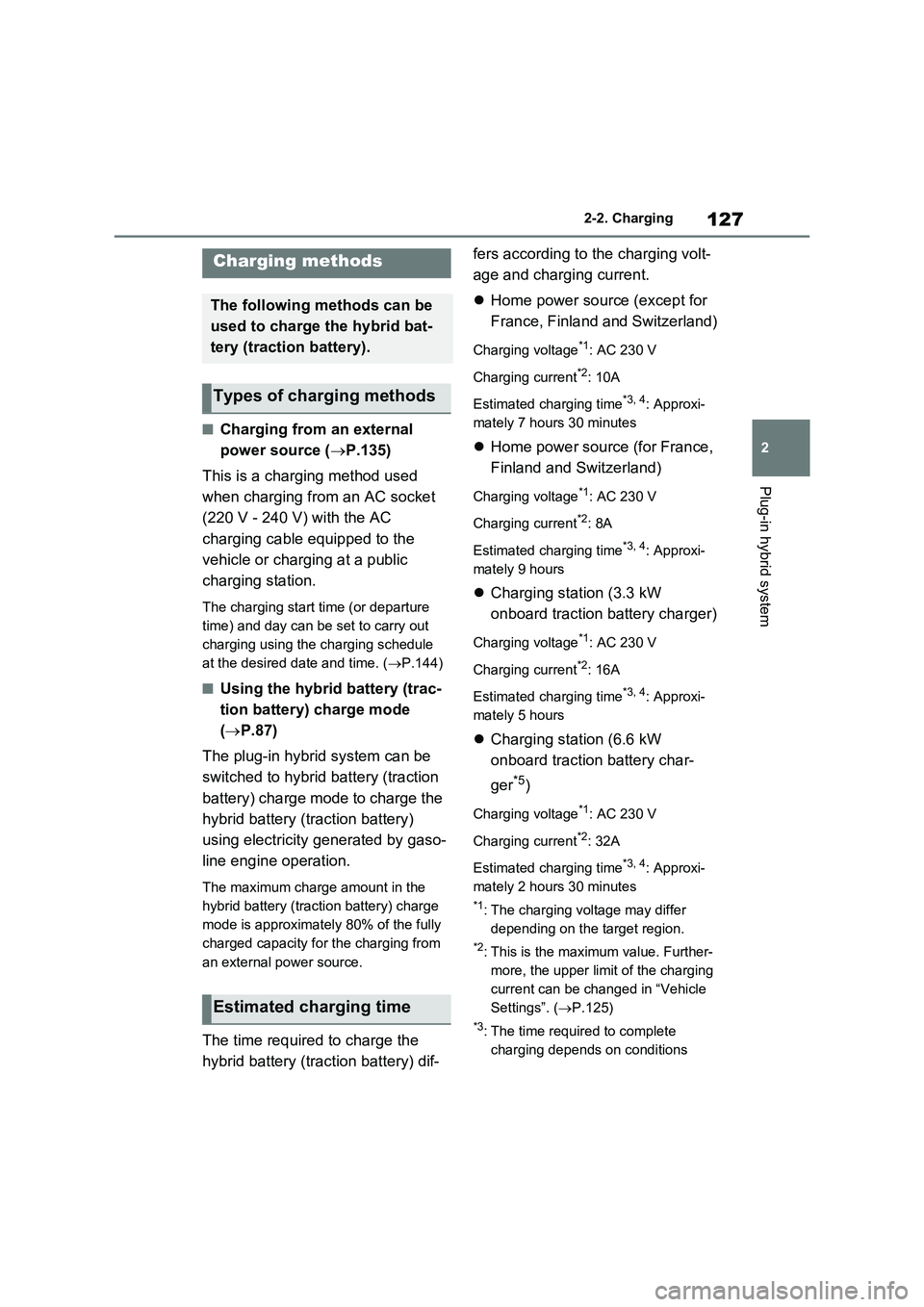
127
2 2-2. Charging
Plug-in hybrid system
■Charging from an external
power source (P.135)
This is a charging method used
when charging from an AC socket
(220 V - 240 V) with the AC
charging cable equipped to the
vehicle or charging at a public
charging station.
The charging start time (or departure
time) and day can be set to carry out
charging using the charging schedule
at the desired date and time. (P.144)
■Using the hybrid battery (trac-
tion battery) charge mode
(P.87)
The plug-in hybrid system can be
switched to hybrid battery (traction
battery) charge mode to charge the
hybrid battery (traction battery)
using electricity generated by gaso-
line engine operation.
The maximum charge amount in the
hybrid battery (traction battery) charge
mode is approximately 80% of the fully
charged capacity for the charging from
an external power source.
The time required to charge the
hybrid battery (traction battery) dif-fers according to the charging volt-
age and charging current.
Home power source (except for
France, Finland and Switzerland)
Charging voltage*1: AC 230 V
Charging current
*2: 10A
Estimated charging time
*3, 4: Approxi-
mately 7 hours 30 minutes
Home power source (for France,
Finland and Switzerland)
Charging voltage*1: AC 230 V
Charging current
*2: 8A
Estimated charging time
*3, 4: Approxi-
mately 9 hours
Charging station (3.3 kW
onboard traction battery charger)
Charging voltage*1: AC 230 V
Charging current
*2: 16A
Estimated charging time
*3, 4: Approxi-
mately 5 hours
Charging station (6.6 kW
onboard traction battery char-
ger
*5)
Charging voltage*1: AC 230 V
Charging current
*2: 32A
Estimated charging time
*3, 4: Approxi-
mately 2 hours 30 minutes
*1: The charging voltage may differ
depending on the target region.
*2: This is the maximum value. Further-
more, the upper limit of the charging
current can be changed in “Vehicle
Settings”. (P.125)
*3: The time required to complete
charging depends on conditions
Charging methods
The following methods can be
used to charge the hybrid bat-
tery (traction battery).
Types of charging methods
Estimated charging time
Page 134 of 664
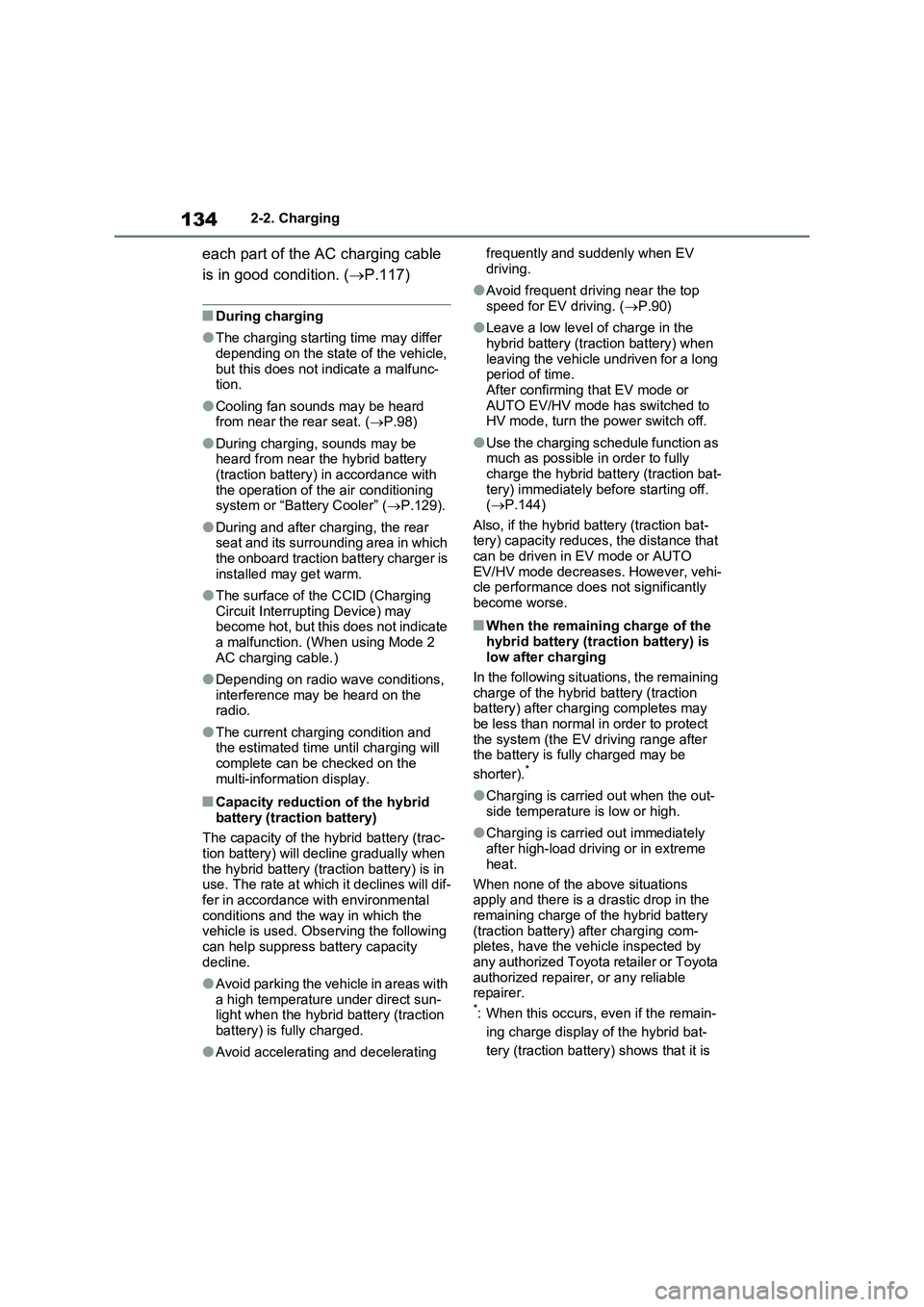
1342-2. Charging
each part of the AC charging cable
is in good condition. (P.117)
■During charging
●The charging starting time may differ
depending on the state of the vehicle,
but this does not indicate a malfunc-
tion.
●Cooling fan sounds may be heard
from near the rear seat. (P.98)
●During charging, sounds may be
heard from near the hybrid battery
(traction battery) in accordance with
the operation of the air conditioning
system or “Battery Cooler” (P.129).
●During and after charging, the rear
seat and its surrounding area in which
the onboard traction battery charger is
installed may get warm.
●The surface of the CCID (Charging
Circuit Interrupting Device) may
become hot, but this does not indicate
a malfunction. (When using Mode 2
AC charging cable.)
●Depending on radio wave conditions,
interference may be heard on the
radio.
●The current charging condition and
the estimated time until charging will
complete can be checked on the
multi-information display.
■Capacity reduction of the hybrid
battery (traction battery)
The capacity of the hybrid battery (trac-
tion battery) will decline gradually when
the hybrid battery (traction battery) is in
use. The rate at which it declines will dif-
fer in accordance with environmental
conditions and the way in which the
vehicle is used. Observing the following
can help suppress battery capacity
decline.
●Avoid parking the vehicle in areas with
a high temperature under direct sun-
light when the hybrid battery (traction
battery) is fully charged.
●Avoid accelerating and decelerating frequently and suddenly when EV
driving.
●Avoid frequent driving near the top
speed for EV driving. (P.90)
●Leave a low level of charge in the
hybrid battery (traction battery) when
leaving the vehicle undriven for a long
period of time.
After confirming that EV mode or
AUTO EV/HV mode has switched to
HV mode, turn the power switch off.
●Use the charging schedule function as
much as possible in order to fully
charge the hybrid battery (traction bat-
tery) immediately before starting off.
(P.144)
Also, if the hybrid battery (traction bat-
tery) capacity reduces, the distance that
can be driven in EV mode or AUTO
EV/HV mode decreases. However, vehi-
cle performance does not significantly
become worse.
■When the remaining charge of the
hybrid battery (traction battery) is
low after charging
In the following situations, the remaining
charge of the hybrid battery (traction
battery) after charging completes may
be less than normal in order to protect
the system (the EV driving range after
the battery is fully charged may be
shorter).
*
●Charging is carried out when the out-
side temperature is low or high.
●Charging is carried out immediately
after high-load driving or in extreme
heat.
When none of the above situations
apply and there is a drastic drop in the
remaining charge of the hybrid battery
(traction battery) after charging com-
pletes, have the vehicle inspected by
any authorized Toyota retailer or Toyota
authorized repairer, or any reliable
repairer.
*: When this occurs, even if the remain-
ing charge display of the hybrid bat-
tery (traction battery) shows that it is
Page 136 of 664
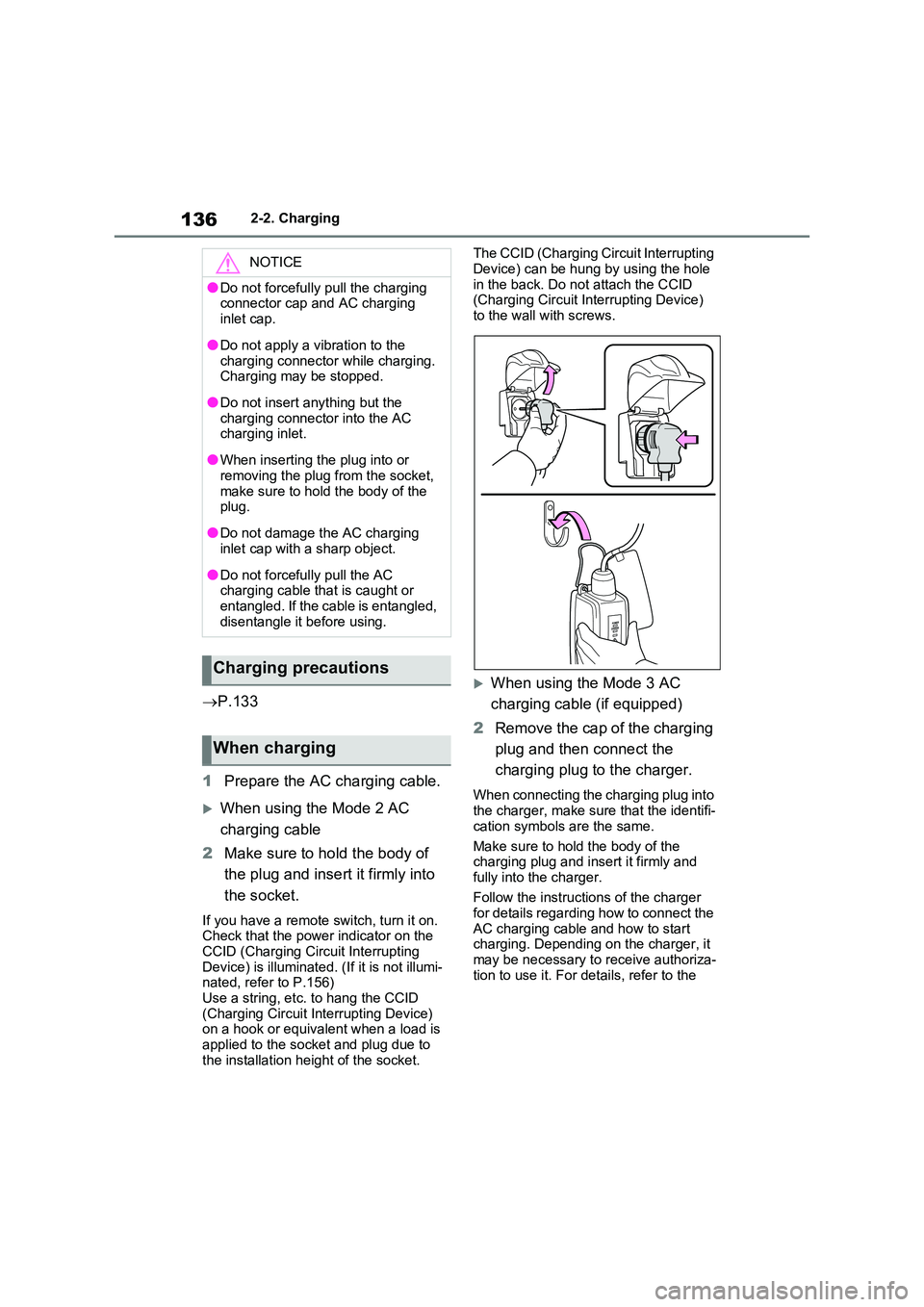
1362-2. Charging
P.133
1 Prepare the AC charging cable.
When using the Mode 2 AC
charging cable
2 Make sure to hold the body of
the plug and insert it firmly into
the socket.
If you have a remote switch, turn it on. Check that the power indicator on the
CCID (Charging Circuit Interrupting Device) is illuminated. (If it is not illumi-nated, refer to P.156)
Use a string, etc. to hang the CCID (Charging Circuit Interrupting Device) on a hook or equivalent when a load is
applied to the socket and plug due to the installation height of the socket.
The CCID (Charging Circuit Interrupting
Device) can be hung by using the hole in the back. Do not attach the CCID (Charging Circuit Interrupting Device)
to the wall with screws.
When using the Mode 3 AC
charging cable (if equipped)
2 Remove the cap of the charging
plug and then connect the
charging plug to the charger.
When connecting the charging plug into the charger, make sure that the identifi-
cation symbols are the same.
Make sure to hold the body of the charging plug and insert it firmly and
fully into the charger.
Follow the instructions of the charger for details regarding how to connect the
AC charging cable and how to start charging. Depending on the charger, it may be necessary to receive authoriza-
tion to use it. For details, refer to the
NOTICE
●Do not forcefully pull the charging connector cap and AC charging
inlet cap.
●Do not apply a vibration to the
charging connector while charging. Charging may be stopped.
●Do not insert anything but the charging connector into the AC charging inlet.
●When inserting the plug into or removing the plug from the socket,
make sure to hold the body of the plug.
●Do not damage the AC charging inlet cap with a sharp object.
●Do not forcefully pull the AC charging cable that is caught or entangled. If the cable is entangled,
disentangle it before using.
Charging precautions
When charging
Page 137 of 664
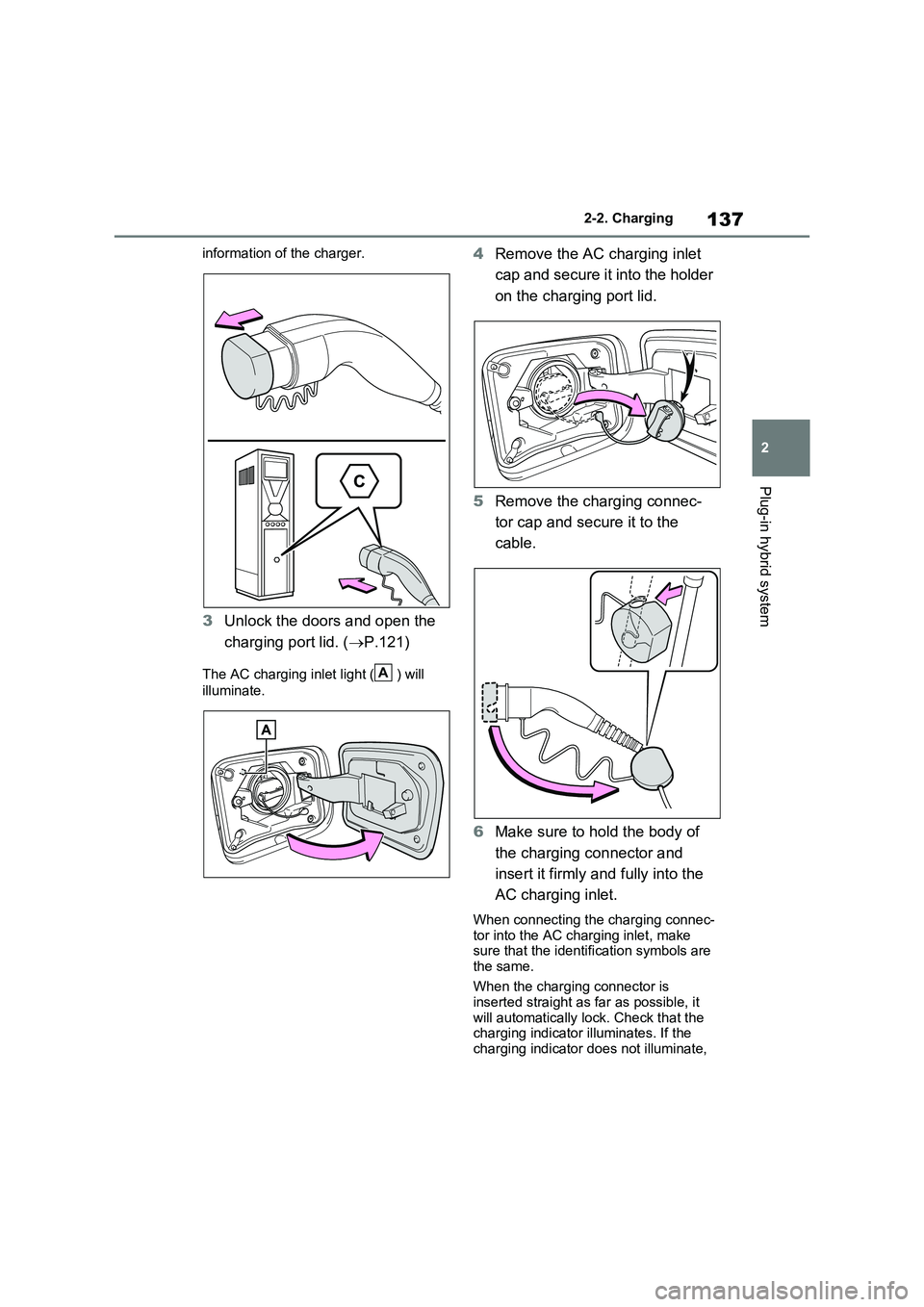
137
2 2-2. Charging
Plug-in hybrid system
information of the charger.
3Unlock the doors and open the
charging port lid. (P.121)
The AC charging inlet light ( ) will
illuminate.
4Remove the AC charging inlet
cap and secure it into the holder
on the charging port lid.
5Remove the charging connec-
tor cap and secure it to the
cable.
6Make sure to hold the body of
the charging connector and
insert it firmly and fully into the
AC charging inlet.
When connecting the charging connec-
tor into the AC charging inlet, make
sure that the identification symbols are
the same.
When the charging connector is
inserted straight as far as possible, it
will automatically lock. Check that the
charging indicator illuminates. If the
charging indicator does not illuminate,
A